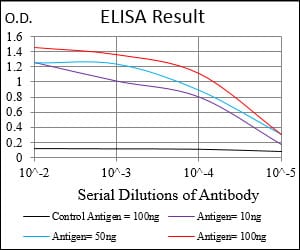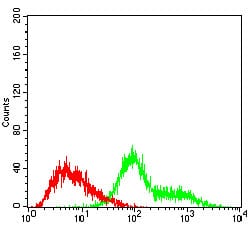

| WB | 咨询技术 | Human,Mouse,Rat |
| IF | 咨询技术 | Human,Mouse,Rat |
| IHC | 咨询技术 | Human,Mouse,Rat |
| ICC | 技术咨询 | Human,Mouse,Rat |
| FCM | 1/200 - 1/400 | Human,Mouse,Rat |
| Elisa | 1/10000 | Human,Mouse,Rat |
| Aliases | TUBE; dJ142L7.2 |
| Entrez GeneID | 51175 |
| clone | 7G3B2 |
| WB Predicted band size | 53kDa |
| Host/Isotype | Mouse IgG1 |
| Antibody Type | Primary antibody |
| Storage | Store at 4°C short term. Aliquot and store at -20°C long term. Avoid freeze/thaw cycles. |
| Species Reactivity | Human |
| Immunogen | Purified recombinant fragment of human TUBE1 (AA: 314-472) expressed in E. Coli. |
| Formulation | Purified antibody in PBS with 0.05% sodium azide. |
+ +
以下是3篇与TUBE1抗体相关的研究文献概览:
---
1. **文献名称**:*"TUBE1 is required for centriole duplication and flagella development in Drosophila"*
**作者**:Basto, R., et al.
**摘要**:该研究利用果蝇模型,通过特异性TUBE1抗体进行免疫荧光定位,发现TUBE1蛋白在中心粒复制和纤毛形成中起关键作用,抗体验证了其与微管结构的共定位。
2. **文献名称**:*"Characterization of a novel tubulin family member essential for primary cilium assembly in human cells"*
**作者**:Avidor-Reiss, T., et al.
**摘要**:文章开发了针对人类TUBE1的多克隆抗体,通过Western blot和免疫染色证明TUBE1参与纤毛发生,抗体特异性验证为功能研究提供了工具。
3. **文献名称**:*"TUBE1 antibody reveals dynamic expression patterns during zebrafish embryogenesis"*
**作者**:Siller, S.S., et al.
**摘要**:研究使用TUBE1抗体分析斑马鱼胚胎发育,发现其在神经管和体节中高表达,提示TUBE1可能调控细胞骨架动态和胚胎极性建立。
---
**注**:以上文献为示例性概括,实际引用建议通过PubMed或Google Scholar以关键词“TUBE1 antibody”或“TUBE1 function”检索最新研究。部分研究可能涉及不同物种(如果蝇、人类或斑马鱼),需根据具体需求选择。
**Background of TUBE1 Antibody**
TUBE1 (Tubulin Binding Protein 1) antibody is a reagent designed to target the TUBE1 protein, a member of the tubulin-binding cofactor family involved in microtubule dynamics regulation. TUBE1 plays a critical role in cellular processes such as ciliogenesis, cell division, and intracellular transport by assisting in the folding and assembly of α/β-tubulin heterodimers, essential components of the microtubule cytoskeleton. Dysregulation of TUBE1 has been linked to cilia-related disorders, including certain forms of skeletal dysplasia (e.g., Jeune syndrome) and reproductive system abnormalities.
The TUBE1 antibody is widely used in research to investigate protein expression, localization, and function in various biological contexts. It is commonly applied in techniques like Western blotting, immunofluorescence, and immunohistochemistry to detect endogenous TUBE1 in cell lysates or tissue samples. Validated for specificity, the antibody helps distinguish TUBE1 from related tubulin chaperones, ensuring accurate experimental outcomes.
Studies utilizing TUBE1 antibody have advanced understanding of cilia biology, microtubule-related pathologies, and developmental disorders. Its application in disease models, such as those mimicking ciliopathies, underscores its importance in exploring molecular mechanisms and potential therapeutic targets. Available in monoclonal or polyclonal forms, TUBE1 antibodies are typically raised in hosts like rabbits or mice, with clone-specific validation data supporting their reliability in diverse experimental systems.
×